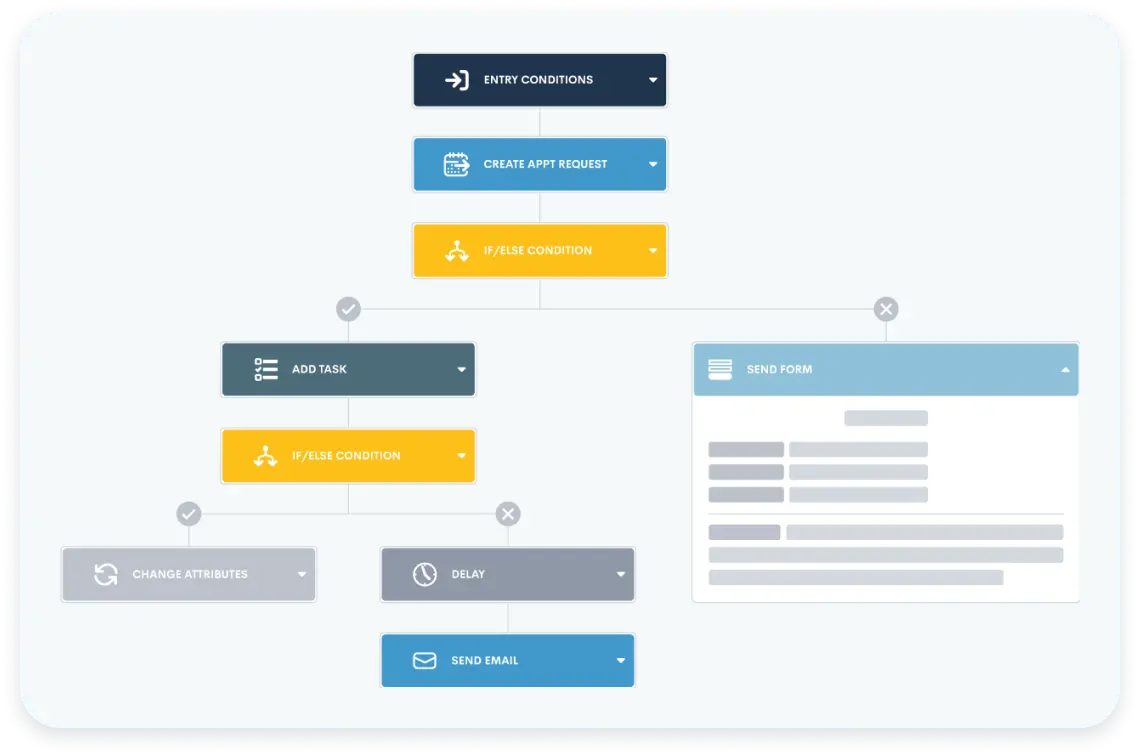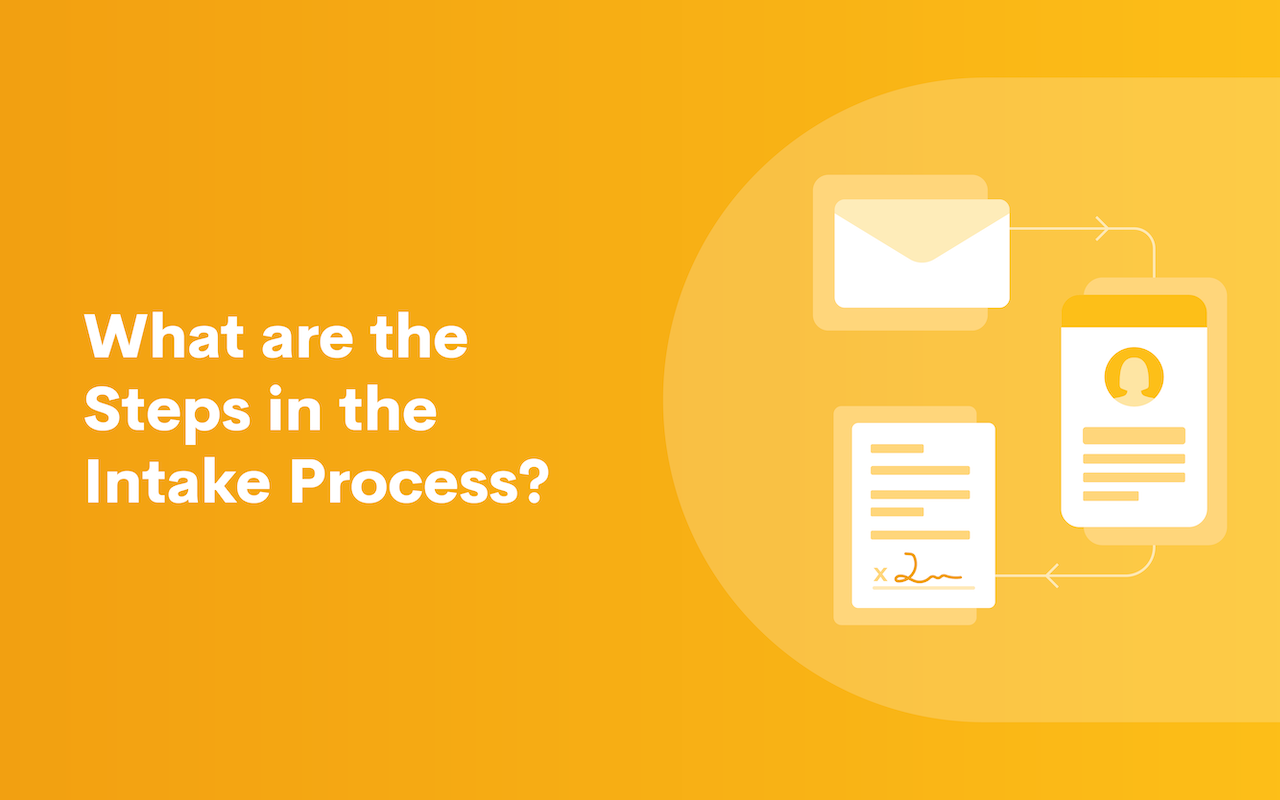What are the Steps in the Intake Process?

Client intake is extremely important for law firms, as it establishes the attorney-client relationship and converts a prospect into a paying client. Although law firms traditionally completed intake manually, legal client intake automation and the use of intake process templates can dramatically streamline the process by engaging and retaining new clients faster than ever before.
What is the intake phase for a law firm?
The intake phase is the first step that potential clients take. An efficient intake process is critical to ensure that a law firm can effectively evaluate potential cases, provide appropriate legal advice, and ultimately provide solid legal representation. Here’s a client intake process example utilizing automation:
Dana is looking for legal help and reaches out to an attorney by filling out a custom intake form directly embedded into the firm’s website. She schedules an appointment with the firm’s legal calendaring software, and receives an automated reminder. Before the appointment, the firm’s technology automatically pre-screens the case for viability and performs a conflict check. She then attends the appointment and decides to hire the attorney. A retainer agreement is automatically generated which Dana signs electronically, after which it is sent back to the attorney for signature. Work on the case can begin.
How does the intake stage work?
The intake stage generally involves engaging with potential clients through initial contact, screening for case viability, conducting conflict checks, and setting up consultations to establish the attorney-client relationship. Many firms perform manual client intake processes, which can present several challenges. Manual intake workflows tend to be:
- Time consuming. Manual intake is time consuming and involves significant time and effort, which can lead to delays in retaining new clients.
- Error prone. Manual data entry increases the risk of typos, missing information, inaccuracies, and other errors.
- Limited access. Paper-based intake forms are often difficult to access and share among staff members, particularly if they are stored in physical files across various locations.
- A security risk. When sensitive client information is stored in paper files or shared via unsecured channels, this can expose the firm to data breaches and regulatory noncompliance.
- A bad client experience. Lengthy and burdensome intake processes can lead to client frustration and dissatisfaction and as a result, they might look for firms with more streamlined processes.
When firms automate their intake process, they can improve efficiency, accuracy, and client service while reducing risks and costs associated with manual methods.
What are the parts of the intake process?
Here’s are the typical steps taken during the client intake process:
- Initial contact. Potential clients often reach out to a law firm via phone, email, or through the firm's website contact form and fill out a questionnaire to provide basic information about their legal issue and their interest in obtaining legal representation.
- Screening. The law firm's intake team or attorneys gather more details about the legal matter, such as the nature of the issue, relevant dates, parties involved, and any prior legal actions taken.
- Conflict check. The firm will conduct a conflict check to ensure that there are no conflicts of interest that would prevent them from representing the potential client, including any prior or existing relationships with parties involved in the case.
- Consultation. If the case passes the initial screening and conflict check, the potential client may be scheduled for an initial consultation to review the details of the case, discuss the legal options available, and provide preliminary advice on how to proceed.
- Retainer agreement. If both the client and the attorney agree to move forward with representation, they will typically sign a retainer agreement outlining the legal fees, scope of services, and other relevant terms and conditions.
What are the objectives of the intake process?
The legal intake process has several critical objectives, including:
- Gathering information. Essential information about potential clients and their legal issues is gathered during intake.
- Managing risk. By conducting conflict checks and screening potential clients, the intake process helps manage the ethical, legal, and reputational risks of taking on a new case.
- Setting expectations. During intake, attorneys set clear expectations with potential clients about the scope of the representation, legal fees, timelines, and potential outcomes.
- Building relationships. Effective intake procedures allow attorneys to establish positive relationships with potential clients, fostering trust, confidence, and rapport.
- Streamlining workflow. A well-designed intake process helps reduce administrative burdens, minimize redundancies, and improve overall efficiency.
An efficient legal intake process lays the foundation for successful attorney-client relationships and effective representation.
How do I create a client intake for a law firm?
A law firm client intake process template can help firms establish a clear, consistent, and efficient intake process. Here’s a law firm client intake process flow chart that illustrates how automated intake works:

Source: Lawmatics
With automated intake, potential new clients can seamlessly submit an inquiry to a firm via user-friendly software that will optimize the intake process and quickly convert prospective clients into paying clients.
Lawmatics: the intake answer for law firms
Investing in a client intake software system won’t just make your job easier; it can dramatically impact your profits. To learn more about how Lawmatics client intake software can help organize your leads, optimize client follow-ups, and secure more business, download our e-book, “How to Gain More Business, While Saving Time with Client Intake Software” today.


